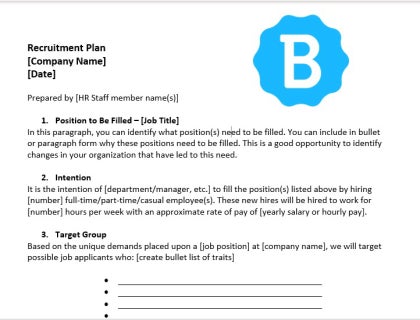
Recruitment Plan Template Free Download
Download our free Recruitment Plan template in Microsoft Word format.
Download NowHow to Develop a Recruitment Strategy:

Recruiting a new employee can be time-consuming and expensive, particularly if you don't have a clear direction. If you have a predetermined plan in place, you can be consistent in your recruitment efforts and direct your resources to a series of strategies that will help you find the kind of people you want to hire.
Figure out what position needs to be filled.
Identify a gap in your workforce.

You can't hire new employees unless you know exactly what role you need to slot them into. If you've identified a gap in your company's workforce that has been created by someone else's departure, or by the growth and evolution of your organization, that gap needs to be filled by someone who is qualified to meet the demands of that particular role.
Discuss the requirements of the role.

Anytime you begin the recruitment process, you should start by identifying very clearly what you are looking for. Work with your HR team, as well as departmental team leaders, to outline the requirements and responsibilities of each role. You should also outline the daily responsibilities and goals of each role.
Working with the HR team and departmental leaders ensure that everyone is on the same page and have a thorough understanding of each role.
Develop your recruitment strategy.
Decide how the job(s) will be filled.

Knowing what positions are vacant is only the start. How are you going to meet the need of your company? You will need to ask some important questions when you are drawing up a plan, like:
Will you hire multiple people? Will you look for a part-time or full-time employee? Will there be a trial period? Will you hire over the course of the next week or the next month?
Estimate your hiring needs.

These questions and more can help you to estimate how many people you will need in each department and approximately when you will need to hire them. Then, you can build a recruitment calendar for the year ahead.
Plan out a budget for your recruitment needs.

To keep your recruiting costs down, plan a budget for the year ahead based on the estimates you've done so far. Some of the usual costs include advertising, recruitment tools, career fairs, branding expenses, background checks, and travel expenses.
Decide how you will search for candidates.
Decide on the type of candidates that should be targeted.

What type of characteristics make up your target group? It might be education, work experience, years of service, geographic location, or some other attribute.
Think about where to search for applicants.

Picking out several characteristics can help you to narrow down your search pool and have a better idea of where to look. For instance, most general laborers won't be active on LinkedIn, but seasoned professionals are likely to frequent LinkedIn and keep an up-to-date profile.
Consider how you will screen your applicants.
Connect with your target group.

There are a number of ways to make the first point of contact with your target group. These include:
- Job boards.
- Social media sites.
- Job fairs.
- Career days.
- Staffing agencies.
Start a conversation with candidates and keep in touch.
The list above includes some of the most common ways for employers to start a conversation with prospective employees. You can also keep in touch with your prospective employees by using applicant tracking systems. These tools will help you to streamline your application process and stay organized.
Evaluate your target group.
Come up with a method for evaluating your candidates.

The success of your recruitment plan comes down to how you evaluate the candidates. A job interview is a must for virtually any position, but job interviews can be conducted in a variety of ways.
Some companies opt for a series of interviews so that they can narrow down candidates and go a little deeper with shortlisted applicants in their second conversation. Others conduct only one interview but ask the candidates to take a short assessment to test their skills or knowledge in a certain area.
Plan for other evaluation and control methods.

You can also do your due diligence with employee background checks and calls to references.
Lay out the groundrules for making an offer to your chosen candidate.

Your recruitment plan should define who makes the offer to the chosen candidate and performs any further negotiations. You can also lay out how the offer will be made and draft an official agreement letter.
Continue to review and edit your plan as you go.

Your recruitment plan should reflect the growth of your company, so continually review your recruitment process and make changes to your plan. This will ensure your recruitment strategy is always efficient and effective.
Why is a recruitment plan important?
Before you struggle with your recruiting efforts and scratch your head wondering why you aren't able to find the candidates that you're looking for, sit down and come up with a recruiting plan. With the right recruiting strategies and steps in place, you can exponentially increase the quality of your results. You can use our recruitment plan sample above to help you get started.
Free Background Check Services


